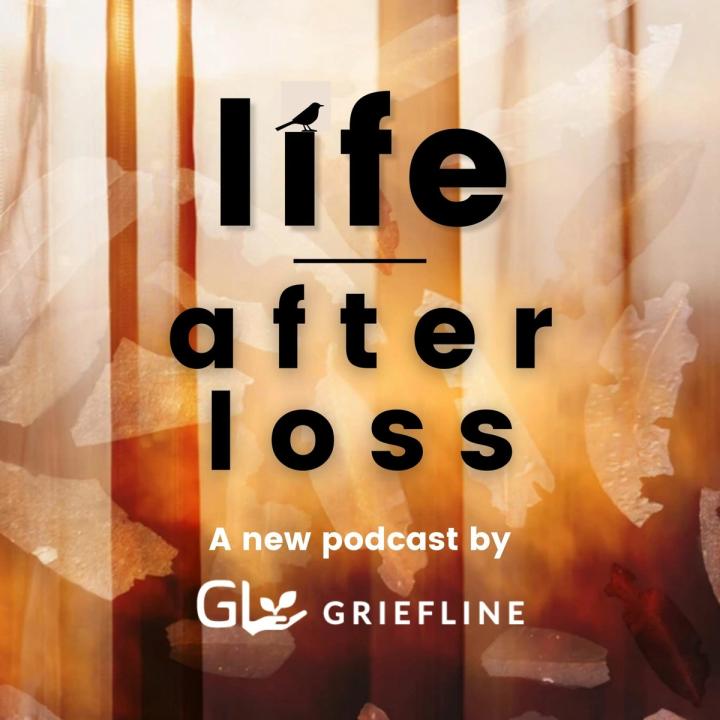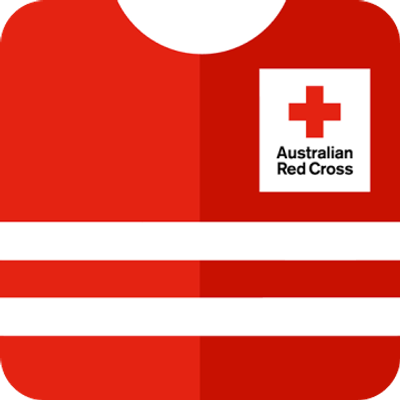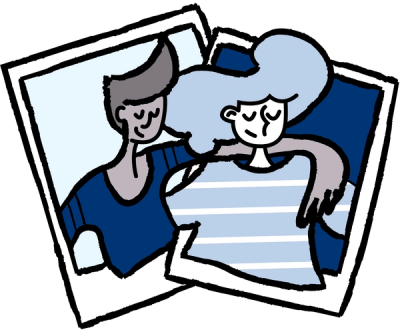Lilly and Lee's Stories
On the 9th and 10th of June 2021, a severe storm swept through the Dandenong Ranges in Victoria, significantly impacting both the natural landscape and the local community.
In this episode of Griefline's Life After Loss podcast, Lilly Markovic and Lee Burgess share their lived experiences and reflect on the trauma, grief, and sense of loss that followed.
Natural disaster recovery expert, Dr Rob Gordon, also offers his insights into understanding trauma, how it differs from grief and loss, and the significance of rituals, anniversaries, and storytelling in the recovery process.
The Life After Loss podcast is produced by Griefline. For more resources and support, please visit griefline.org.au.
Listen here
Read transcript
Note: this transcript has been edited for clarity, grammar, and flow.
Louisa Smith: Griefline acknowledges the Australian Aboriginal people as the First Peoples and traditional custodians of the land and water on which we live, work, and depend. We pay our respects to Aboriginal Elders past and present. We acknowledge that our country has been protected and cared for by Aboriginal people for tens of thousands of years. We recognise the unique spiritual and cultural significance of land, water, and all that is in the environment to Aboriginal people and traditional custodians. We also recognise their intrinsic connection to and aspirations for Country.
Amanda Trotter: A quick trigger warning: Life After Loss explores real-life experiences of grief, loss, and trauma. We also discuss some of Australia's worst natural disasters and their effects on people and the environment. If you find these topics distressing or triggering, please assess whether you feel supported enough to continue listening. Remember, Griefline understands that whatever your loss is, it’s personal to you. In addition to our toll-free helpline and booked call service, we offer national bereavement support groups, online community forums, grief and loss information and resources on our website, and corporate and volunteer training programs. To access our programs and services, visit griefline.org.au.
News Reader 1: Another round of severe weather is set to hit the Dandenong Ranges this week, with heavy rain expected.
News Reader 2: We currently have around 7,000 households without power, and thousands more may remain without power well into next month.
News Reader 3: On the evening of the 9th of June, the Dandenong Ranges were hit by a severe storm, which brought down thousands of trees and branches, having a huge impact on the community.
Louisa Smith: Life After Loss is a podcast brought to you by Griefline. For 35 years, Griefline has supported people in the community who are experiencing grief and loss. Over that time, tens of thousands of people have reached out to us for support and understanding via our helpline, forums, and socials. Each one of them has a story as unique as their grief experience. The one thing that unites them is a need for connection and understanding—someone to listen and validate their grief.
Amanda Trotter: This podcast gives us the opportunity to reach out to people with lived experiences of grief and share our courageous conversations with you. It won’t fix the grief or take away the loss, but it will help to normalise the experience, to question, inform, and challenge, and to discover tangible ways to find hope. Most of all, it’s an opportunity to explore how we can grow around grief and find meaning again.
Louisa Smith: Our first series focuses on natural disasters—bushfires, droughts, floods—all catastrophic events that are frequently recurring and increasing in intensity, leaving a trail of visible destruction behind. But it’s the unseen devastation that we’ll focus on—the broken hearts and minds of the people left in their wake.
Amanda Trotter: By sharing the narratives of survivors, we witness their grief and discover how they’ve found a way to live each day—perhaps finding purpose in their lives, rediscovering hope, or making meaning from their experience. Ultimately, we hope to explore how they find life after loss.
Lilly Markovic: That sound—I can’t even describe it.
Lee Burgess: Can you try to describe it to people? It’s like, if you can imagine a moment where, in a split second, there’s smashing glass, ripping tin, cracking wood, and the thump of a tree. It’s all combined into a single second. And in that moment, the house is destroyed.
Louisa Smith: On the 9th and 10th of June 2021, an extreme storm struck one of Victoria’s most picturesque areas—the Dandenong Ranges. The effects were devastating, both to the natural bushland and its human inhabitants. More than 25,000 trees were brought down, clearing swathes of forest and destroying the canopy in many areas. 177 properties were damaged, leaving 76 homes uninhabitable.
There are countless stories of terror, as residents cowered in their homes while trees crashed to the ground or through their roofs. Stories of accidents, near misses, and fears of lost loved ones abound. Miraculously, and thankfully, no one was killed.
What followed were days and even weeks without power, telecommunications, or road access, causing confusion and a sense of abandonment for many in the community. While people in Greater Melbourne went about their lives, those up on the mountain were trapped in their homes in the middle of winter, without heat, water, and in some cases, access to food or medication.
A year on, insurance losses are estimated at more than $300 million, with costs still rising. The living losses are immense—not just homes, but gardens lovingly tended for decades, family heirlooms, a sense of place, and a sense of identity. The emotional toll on survivors has been overwhelming. Some families chose to leave the mountain and never return, while others continue living in temporary accommodation as they navigate insurance claims, permits, and building plans, hoping to return to a new kind of home at some point.
As we record this, the first anniversary of the storm has just passed. While some people prefer not to dwell on the event, others have expressed a need to reflect and share their experiences. In this episode, we feel privileged to witness one such story.
Rob Gordon: I think there’s a sense of grief fatigue and kindness within the community. For those who suffered losses and damage, there’s still a long way to go. One thing I discover all the time is that people caught up in a disaster have no idea how long the recovery will actually take. You might think, “How long does it take to repair or rebuild a house?” That’s not the main issue—the issue is all the cleanup, the insurance, the permits, and the availability of tradesmen. It takes years—honestly, years. It’s important for people to adjust their expectations. Our frustration comes from the gap between what we expect and what actually happens. If we can shift our expectations to be more realistic, we won’t feel as frustrated.
Amanda Trotter: Rob, when we conducted these interviews, it was just after the first anniversary of the storm. Can you tell us more about the significance of anniversaries in the grieving process?
Rob Gordon: Anniversaries play a significant role in the grief process. They can stir up feelings of restlessness and fear. As the anniversary approaches, there’s often a sense of foreboding. On the day itself, it can be extremely tough for people. Grief is deeply personal, and people respond to anniversaries in their own unique way. In the lead-up and on the day, there may be experiences of anger, flashbacks, depression, anxiety, and even nightmares. It’s an emotionally charged time.
Louisa Smith: At the same time, anniversaries can present an opportunity to acknowledge the painful memories and triggers, to remember the losses associated with the disaster, and to take stock of the accomplishments during the year since. It’s also a chance to recognise the people who supported us through the trauma and to appreciate the resilience we’ve developed along the way.
Amanda Trotter: Exactly. It’s a time when we can look back and say, “It’s been tough, but look at what we’ve achieved.” That achievement might be as simple as getting out of bed each day and continuing on, despite the grief and trauma. That in itself is a huge accomplishment.
In this episode, we’re looking forward to hearing from Dr Rob Gordon, who has a deep understanding of trauma and the importance of anniversaries. We’re also excited to speak with Lee Burgess and Lilly Markovic about their experience on the mountain that night, and their reflections on the anniversary.
Lilly Markovic: In my head, I’ve tried so many times to reverse it—like pressing rewind on a video. I’d hug the tree in my mind, pull it back up, and reverse the whole situation. The thoughts that go through your head in seconds... it’s incredible—the fears...
Lee Burgess: In a split second, we were in bed, asleep, and then the next minute, the trunk of the tree is in our bedroom, the bathroom’s destroyed. Just bang—it happened that fast.
Lilly Markovic: Yeah. I jumped out of bed. I didn’t even see that the tree had come through the roof. I just thought, “Where is it? Where’s the tree? It’s not here.” And then it hit me—oh my God, it’s the kids. The kids are dead. That was my only thought. I started screaming and ran to the other side of the house, just screaming my head off.
I ran from the bedroom, through the kitchen, and I had to go under the tree. I looked up and saw it had come through Isla’s room. We all met in Isla’s room. But Isla wasn’t saying a word. She was buried under the rubble. I thought, “She’s dead. She’s dead.” That’s all I could think of.
Even when I rushed into her bedroom, there was plasterboard and a heavy mirror that had fallen on top of her. She didn’t say anything. That silence—her not talking—it was terrifying. I honestly thought she was gone. It was the most horrific moment. First, thinking I’d lost all four children. Then realising three were safe, but Isla... I thought she was dead. There are no words to describe the feeling of losing everything and knowing you can’t reverse the situation.
Amanda Trotter: That’s such an intense experience, Lilly. I want to thank you and Lee for your vulnerability and for sharing your story with us. You’ve both been through something so traumatic, but you’ve shown incredible strength in the way you’re navigating life after the storm.
Louisa Smith: And Rob, you’ve been working with people and communities affected by trauma for over 30 years. Can you tell us what the feeling is like among the community members now, especially as we’ve just passed the first-year anniversary?
Rob Gordon: It’s really important to understand that trauma, by definition, is a form of injury or damage—psychological damage to the structure of the experience that normally helps us make sense of things and feel in control.
When that structure is damaged, we can’t recover from it easily, and we keep returning to that terrible moment. Trauma disrupts our taken-for-granted assumptions about life. For example, you go to bed when the wind blows, expecting to wake up safely in the morning. When that basic sense of security is shattered, it’s hard to move forward.
I’ve identified three types of trauma. There’s the actual trauma, like when a tree falls, and someone sustains physical injury or is in danger. Then there’s anticipatory trauma—when you believe you’re going to die, but you don’t. Even though it doesn’t happen, the psychological damage occurs because you’ve made those emotional and mental adjustments to prepare for death.
Finally, there’s informational trauma, where you’re not directly involved but are traumatised by hearing about the event and worrying about loved ones. For example, someone might live far away from the disaster zone but can’t contact family members in the affected area. Not knowing whether their loved ones are safe can cause significant emotional distress.
Research has shown that after disasters like Black Saturday, people who were unable to contact loved ones for a significant period tended to have poorer long-term mental health outcomes. All three types of trauma—whether physical, anticipatory, or informational—can have long-lasting effects.
And when you combine all these traumas with the practical difficulties of recovery—like sorting through insurance, rebuilding homes, and finding a sense of normalcy—the emotional toll is huge. People might not even start processing their trauma until things stabilise, and that can take years.
Amanda Trotter: It’s a slow process, isn’t it? So, now that we’re a year on, what was it like for you, Lilly, to go through the first anniversary?
Lilly Markovic: It was hard. I just wanted to avoid it. Our neighbours, Penny and Adrian, invited us to a BBQ. Lee went, but I couldn’t do it. I didn’t want to be social. I didn’t want to talk about what had happened. I just wanted to pretend the anniversary wasn’t happening. I’ve come a long way since then, but at the time, I just couldn’t revisit it.
Lee Burgess: I took six months off work to focus on rebuilding the house. I’ve spent a lot of time there, but I had to stop when it got too emotional. When you start scratching at the surface, it all comes back up, and you’re back in that moment. I haven’t dealt with this fully yet—I know I haven’t.
Rob Gordon: It’s important to recognise the distinction between trauma and grief. Trauma is about the terrible experience on the day, and grief is about what we’ve lost since then. We didn’t lose lives in this event, which makes the recovery easier in some ways, but people still lost precious things—homes, heirlooms, a sense of security, and identity. We have to grieve for all of that.
Grieving is about internalising those losses and moving forward without the external props that used to support our lives. For example, if someone spent decades cultivating a garden, and it’s destroyed in a storm, they have to grieve that loss. The trauma and the grief are incompatible processes—trauma pulls us back to the moment of the event, while grief pulls us forward to deal with the loss.
When people are caught up in the disruption of practical recovery—dealing with insurance, accommodation, and so on—they disengage from these emotional processes. Anniversaries can bring everything back up, but they also offer a profound opportunity for people to take control of their recovery. You can choose how to mark the occasion, who to be with, and how to create a symbolic anchor for the future.
Amanda Trotter: Lilly and Lee, how have you managed to keep going through such a challenging year?
Lilly Markovic: We have wonderful friends. Honestly, our friends have been incredible—supporting us, loving us, being there for us. We’ve got a really strong network of friends up here.
Lee Burgess: Yeah, my workplace even did a crowdfunding fundraiser for us.
Lilly Markovic: It felt like everyone had their arms around us, and I just felt like we were in a big hug the whole time.
Rob Gordon: It’s clear that communities like yours are incredibly connected. People talk about these events for years—“How are you doing?” “Wasn’t last night’s storm a bad one?”—it becomes a shared experience. Talking about it helps bring the traumatic memories from the deep, instinctive part of our brain to the more sophisticated, language-based part of our brain. By telling the story repeatedly, we gradually turn the trauma into history, and that’s the key to healing. Trauma lives in the present; history fades into the past.
Lilly Markovic: We’ve started to see the positives. Some days, we even say, “What a blessing the tree fell on our house.” We get to redesign our home and create new things. And we’re just so thankful that everyone is safe. There’s been so much good luck that’s come from the situation.
Louisa Smith: I love the shift in your perspective, Lilly. Talking about the positives that have come from such a traumatic experience—it’s so powerful.
Amanda Trotter: Absolutely. It’s a testament to the kind of people you both are—survivors. Thank you so much for sharing your story with us today. I know it wasn’t easy, but it’s so important for people out there to hear from others who have gone through similar experiences.
Louisa Smith: And Rob, thank you for sharing your insights. I’ve learned so much today about the difference between grief and trauma and how to process them differently. It’s been incredibly comforting to hear.
Amanda Trotter: Yes, and Rob’s suggestion about retelling the story is such a valuable coping strategy. By retelling the story, especially within a community, we can make it part of our history—so we don’t have to live it day in and day out. It becomes part of our story but also something we can leave behind.
Louisa Smith: It’s part of the healing process. As Rob said, it’s like transferring the weight from one foot to the other, slowly moving forward. Healing might not be a quick process, but eventually, you can increase your pace and walk alongside others on the same journey.
Amanda Trotter: That’s a beautiful metaphor. Thank you so much, Lilly, Lee, and Rob. It’s been such a pleasure talking to you, and I hope our listeners found comfort and connection in your stories.
You’ve been listening to the Life After Loss podcast, brought to you by Griefline. Through courageous conversations like this one, we continue to normalise grief and loss as universal human experiences and show how we can learn, adapt, and find life after loss.
Don’t forget to head to the Life After Loss page on our website, where you’ll find photos, links, videos, and more information on our guests, as well as bonus interview content and informative resources. If this podcast raises any issues for you, call the Griefline helpline on 1300 845 745 or use our book-a-call service.
You can also head to our website for online forums, expert advice, and helpful resources. Visit griefline.org.au.
Thank you.
And remember, you are not alone.
Credits
This episode of the Life After Loss podcast was brought to you by Griefline thanks to the NAB Foundation Community Grants Program.
- Co-Hosts – Louisa Smith and Amanda Trotter
- Audio Engineer – Daryl Missen, Vinilo www.vinilo.com.au
- Original Music – Tilly Vickers-Willis
- Creative Producer – Amanda Trotter






